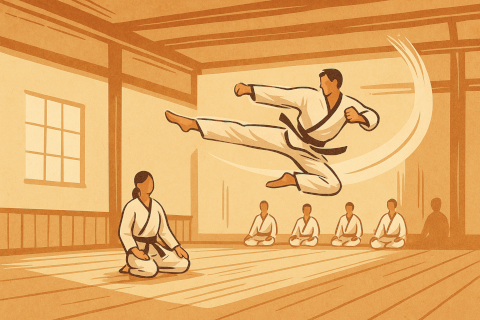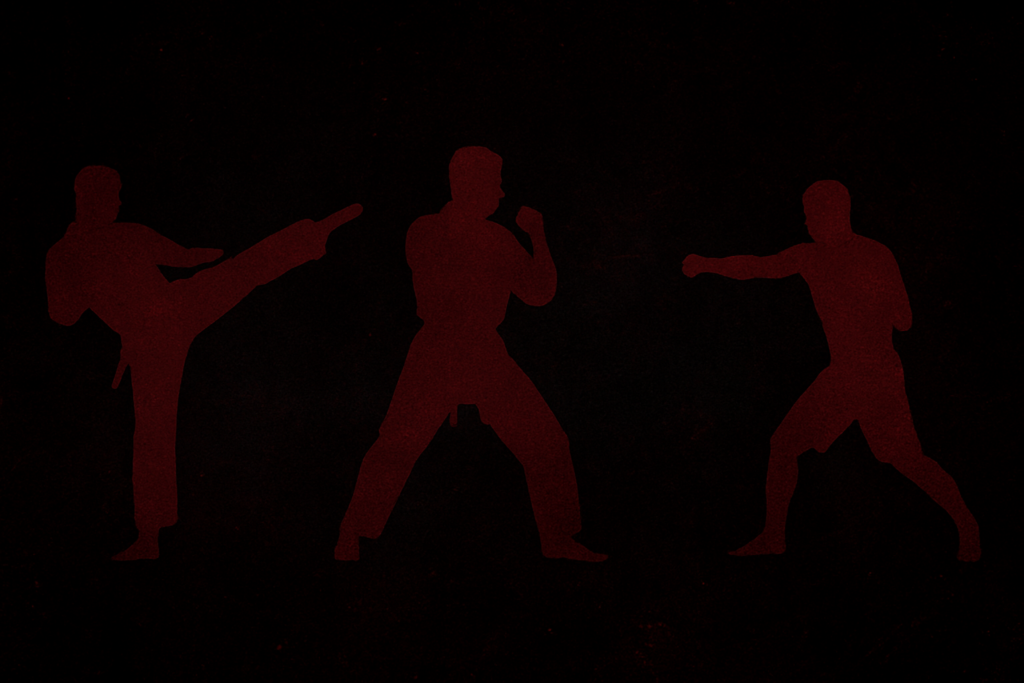The Way of Kicks, Focus, and Discipline
🧠 A Brief History of Taekwondo

Taekwondo (태권도) means “the way of the foot and the fist.”
It is a modern Korean martial art that emphasizes high, fast, and powerful kicks, combined with sharp hand techniques and disciplined mental training.
The roots of Taekwondo stretch back centuries to ancient Korean combat systems like Taekkyeon and Hwa Rang Do, but it was officially founded in the 1950s, after World War II.
A group of Korean martial arts masters — including General Choi Hong Hi (1918–2002) — unified several schools under one national system.
The art evolved rapidly, blending traditional Korean and Japanese techniques into a distinct, dynamic martial discipline.
Today, Taekwondo is one of the most popular martial arts worldwide — and an official Olympic sport since 2000.
🥋 Main Characteristics of Taekwondo
- Core Principle: Speed, accuracy, and balance through disciplined movement.
- Training Focus: Powerful kicks, dynamic footwork, and rapid counterattacks.
- Philosophy: Mental strength, respect, and perseverance.
- Objective: Build physical ability and moral character — “strong mind, strong body.”
Taekwondo is famous for its explosive leg techniques, but it also develops flexibility, coordination, and confidence through structured progression.
⚔️ The Philosophy of Taekwondo
Beyond its physical techniques, Taekwondo teaches a code of ethics known as the Five Tenets:
- Courtesy (Ye Ui) — Be respectful and humble.
- Integrity (Yom Chi) — Be honest and fair in all actions.
- Perseverance (In Nae) — Stay determined through difficulty.
- Self-Control (Guk Gi) — Maintain calmness and discipline.
- Indomitable Spirit (Baekjul Boolgool) — Never give up, even in adversity.
These values make Taekwondo not just a sport, but a path for personal development — shaping better individuals as well as skilled martial artists.
🏯 Major Styles and Organizations
Although Taekwondo began as a unified art, it eventually split into two main branches, each with distinct emphasis:
| Organization / Style | Founder / Origin | Characteristics |
|---|---|---|
| ITF (International Taekwon-Do Federation) | Founded by General Choi Hong Hi in 1966 | Traditional forms (tuls), semi-contact sparring, and emphasis on martial philosophy. |
| WT (World Taekwondo) | Established in 1973 under Dr. Un Yong Kim | Olympic-style sport Taekwondo; focuses on full-contact sparring and athletic performance. |
Despite their differences, both share the same foundation: discipline, technique, and self-improvement.
🦵 Key Techniques
Taekwondo practitioners (taekwondoin) train in a structured format combining traditional forms and free sparring.
Main elements include:
- Kicks (Chagi): Front kick (Ap Chagi), roundhouse (Dollyo Chagi), side kick (Yop Chagi), spinning back kick (Dwi Chagi), and axe kick (Naeryo Chagi).
- Punches and Blocks: Basic hand strikes and defensive movements from Karate influence.
- Forms (Poomsae): Predefined sequences that teach balance, coordination, and focus.
- Sparring (Kyorugi): Controlled combat with protective gear — a key part of Olympic training.
Training builds speed, flexibility, and explosive control, making Taekwondo one of the most athletic martial arts.
🧍♂️ Who Can Practice Taekwondo?
Taekwondo is highly accessible and practiced by people of all ages around the world.
| Group | Benefits |
|---|---|
| Children | Develops discipline, balance, and self-confidence through structured drills. |
| Teens & Adults | Improves fitness, coordination, and stress relief while teaching focus and perseverance. |
| Seniors | Gentle forms and mobility exercises improve flexibility, balance, and mental alertness. |
Because Taekwondo can be trained competitively or recreationally, it suits both athletes and those seeking self-improvement.
💪 Benefits of Practicing Taekwondo
Physical Benefits:
- Enhances leg strength, flexibility, and coordination.
- Boosts cardiovascular fitness and endurance.
- Improves reflexes, posture, and balance.
Mental Benefits:
- Builds focus, self-discipline, and self-confidence.
- Encourages patience, goal-setting, and perseverance.
- Reduces stress through structured training and breathing control.
Social Benefits:
- Promotes teamwork and mutual respect.
- Encourages a global sense of community through tournaments and exchange.
🥇 Taekwondo as a Sport
Taekwondo’s inclusion in the Olympic Games (Sydney 2000) cemented its reputation as a high-performance martial art.
Competitors earn points for clean, controlled strikes using electronic scoring gear and strict refereeing.
Modern competition emphasizes strategy, agility, and timing — turning combat into an elegant display of skill and athleticism.
🌸 Why You Should Try Taekwondo
Taekwondo is the perfect blend of fitness, discipline, and expression.
It’s ideal for those who want to build flexibility, mental clarity, and respect while learning an exciting and dynamic martial art.
🥋 Taekwondo teaches you to reach higher — both in kicks and in life.

